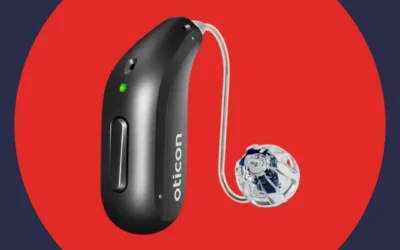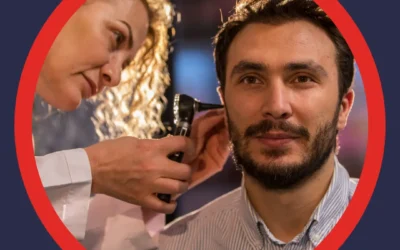Bluetooth hearing aids transform how you connect with the world. These devices stream phone calls, music, and television audio directly to your ears. You control volume independently from everyone around you. The latest models offer hands-free calling and app-based adjustments. Many people report clearer conversations and less listening fatigue.
Modern Bluetooth technology makes hearing aids work like wireless earbuds. You pair them once with your smartphone or tablet. They reconnect automatically each time you turn them on. No extra devices or complicated setup required.
Understanding Wireless Technology in Your Hearing Aids
Bluetooth hearing aids use wireless radio signals to transmit audio. Your smartphone or other device sends sound directly to your hearing aids. This creates a private listening experience only you can hear.
Classic Bluetooth vs. LE Audio: What’s the Difference?
Two types of Bluetooth exist in today’s hearing aids:
Bluetooth Classic powers most current hearing aids. It offers reliable streaming but consumes more battery. You can typically stream for three to four hours before recharging. Connection range reaches about 30 feet from your device.
Bluetooth LE Audio represents the next generation of wireless technology. LE stands for Low Energy. This newer standard uses less power while improving sound quality. Battery life extends significantly compared to Classic Bluetooth. The connection stays stable over longer distances.
LE Audio also enables Auracast broadcast technology. This allows hearing aids to receive audio from public venues. Think airports, theaters, conference centers, and places of worship. Research shows that wireless connectivity significantly enhances user satisfaction with hearing aids. Instead of relying on old loop systems, Auracast broadcasts directly to your devices.
Most hearing aids with LE Audio also support Classic Bluetooth. This ensures compatibility with your current devices while preparing you for future technology.

Phonak: Universal Bluetooth Connectivity
Phonak built its reputation on universal Bluetooth compatibility. Their hearing aids connect to virtually any Bluetooth-enabled device. You pair with smartphones, tablets, computers, and smart TVs seamlessly.
Phonak’s Bluetooth Approach
Phonak uses Bluetooth Classic across its entire lineup. The latest models feature Bluetooth 5.3 for extended range. You can pair up to eight devices simultaneously. Two devices stay actively connected at any time. This makes switching between your phone and laptop effortless.
All Phonak Bluetooth hearing aids support hands-free calling. You answer calls by double-tapping the hearing aid. Your voice transmits through built-in microphones. No need to hold your phone during conversations.
Infinio Platform Models
The Infinio platform represents Phonak’s newest technology. Three models serve different needs and budgets:
Audeo Sphere Infinio features the groundbreaking DEEPSONIC AI chip. This dedicated processor separates speech from noise in real time. Battery life reaches 56 hours without streaming. With moderate streaming, expect approximately 16 hours per charge. The Sphere Ultra version offers the most advanced speech processing available.
Audeo R Infinio provides excellent Bluetooth performance without the AI chip. You still get universal connectivity and hands-free calling. Battery life extends slightly longer than the Sphere models. This option suits users who prioritize connectivity over maximum noise reduction.
Virto Infinio delivers custom in-ear Bluetooth hearing aids. These devices fit entirely within your ear canal. Bluetooth functionality matches the Audeo models. The discreet design appeals to those wanting invisible hearing aids.
All Infinio models are Auracast-ready pending firmware updates. The myPhonak app provides remote control and adjustments. Learn more about Phonak hearing aids and their connectivity options.
Lumity Series
Phonak Lumity hearing aids offer proven Bluetooth technology. These models use Bluetooth 4.2 for reliable streaming. You pair with multiple devices, though the connectivity range is shorter. The Audeo Lumity Life adds waterproof construction for active lifestyles. Lumity remains an excellent choice for cost-conscious buyers wanting Bluetooth.
Starkey: Leading the LE Audio Revolution
Starkey pioneered Bluetooth LE Audio in American hearing aids. Their commitment to next-generation connectivity shows across all recent models. You get improved streaming quality and extended battery life.
Starkey’s Connectivity Innovation
Starkey embraces Bluetooth LE Audio as standard in their latest devices. This provides clearer sound with lower power consumption. Full Auracast functionality comes activated out of the box. You connect to public broadcasts immediately when infrastructure becomes available.
The My Starkey app offers comprehensive control options. TeleHear AI provides remote troubleshooting with 93 percent accuracy. Gen AI Smart Assistant answers questions using natural language. These features reduce the need for in-person adjustments.
Omega AI Platform
Omega AI represents Starkey’s most advanced technology. Six styles accommodate different preferences:
RIC RT and mRIC R rechargeable models feature LED indicator lights. These show power status and Bluetooth connection. Battery life ranges from 41 to 51 hours depending on model. The Find My Hearing Aid feature uses LED flashing for location.
RIC 312 uses traditional disposable batteries for extended wear. You avoid charging concerns on long trips. Bluetooth functionality matches rechargeable versions completely.
Custom models (ITE R, ITC/HS R, CIC) fit within your ear. These provide discreet Bluetooth connectivity in smaller packages. Rechargeable and battery-powered options serve different needs.
DNN 360 directionality delivers up to 28 percent better speech understanding. Signal-to-noise ratio improves by 8 dB in challenging environments. Edge Mode+ provides on-demand clarity with a button press. Discover more about the Starkey Omega AI platform.
Edge AI Platform
Edge AI hearing aids introduced many features now standard in Omega. Bluetooth LE Audio and Auracast functionality work identically. Battery life slightly trails Omega AI models. Edge AI represents excellent value for recent technology at lower prices.
Evolv AI Platform
Evolv AI uses earlier Bluetooth technology but remains highly capable. These hearing aids stream reliably to most devices. You save significantly compared to newer platforms. Evolv AI suits users prioritizing affordability over cutting-edge features.
Explore the complete Starkey hearing aids lineup for detailed comparisons.
ReSound: Intelligent Bluetooth Processing
ReSound combines Bluetooth LE Audio with brain-inspired sound processing. Their Intelligence Augmented approach enhances natural hearing abilities. You experience vivid sound while conserving battery power.
ReSound’s Connectivity Philosophy
ReSound prioritizes natural sound delivery through Bluetooth connections. Their hearing aids feature low battery drain during streaming. Up to 30 hours of use remains possible even with extended streaming.
The ReSound Smart 3D app includes the world’s first Auracast Assistant. This simplifies connecting to public broadcasts when available. You scan for broadcasts and connect with one tap. The interface provides clear guidance throughout the process.
Vivia Platform
ReSound Vivia claims the title of world’s smallest AI hearing aid. Three configurations meet different needs:
MicroRIC Rechargeable delivers 30 hours of battery life per charge. This tiny device hides behind your ear completely. All-weatherproof nanocoating protects against moisture and sweat.
Standard RIC with Size 13 Battery provides longer runtime for heavy users. You swap batteries instead of waiting for charging. Bluetooth features remain identical to rechargeable versions.
RIC with Size 312 Battery offers the smallest disposable battery option. This balances size with extended wear time. All Vivia models support hands-free calling on compatible devices.
Intelligence Augmented AI processes sound using a Deep Neural Network. The system learned from 25 years of conversation data. Intelligent Focus prioritizes speech based on where you look. You face the person you want to hear for best results.
Nexia Platform
ReSound Nexia preceded Vivia with similar Bluetooth LE Audio technology. These hearing aids remain available at attractive prices. Connectivity matches Vivia capabilities exactly. Nexia represents smart value for proven LE Audio performance.
Omnia Platform
Omnia hearing aids use earlier Bluetooth protocols. They stream reliably though battery life is shorter during use. These models suit budget-conscious buyers wanting wireless connectivity. Learn about all ReSound hearing aids options.
Oticon: Sensor-Driven Bluetooth Intelligence
Oticon integrates motion sensors with Bluetooth technology. Their hearing aids adapt based on your physical movements and intentions. This creates seamless transitions between listening environments.
Oticon’s Smart Connectivity
Oticon Intent features Google Fast Pair for Android devices. You pair with one tap on compatible phones. The device syncs automatically across your Google account. This reduces setup time and eliminates frustration.
Bluetooth LE Audio provides improved efficiency over older models. The Intent automatically activates speech enhancement without manual switching. Most users rarely open the companion app. The hearing aids handle adjustments independently.
Intent Platform
Oticon Intent pioneered 4D sensor technology in hearing aids:
MiniRITE R is Oticon’s smallest rechargeable Bluetooth hearing aid. Up to 20 hours of battery life supports all-day use. Quick charge features provide emergency power in minutes. A single button replaces the previous rocker switch.
MiniBTE R accommodates more severe hearing loss levels. Dual fitting levels (85 or 105) serve broader needs. Size 13 rechargeable battery extends runtime significantly. Double-tap call controls provide convenient hands-free operation.
Motion sensors track four dimensions of movement:
- Conversation sensors detect speech in your environment
- Head sensors monitor where you focus attention
- Body sensors track movement through spaces
- Acoustic sensors analyze background noise and room characteristics
Deep Neural Network 2.0 processes these inputs continuously. The system delivers personalized sound without requiring your input. Nine color options allow style customization while maintaining discretion.
Real Platform
Oticon Real hearing aids offer excellent Bluetooth without sensor technology. These connect reliably to iOS and Android devices. Sound processing uses earlier Deep Neural Network versions. Real provides proven performance at accessible prices.
Own Platform
Own custom hearing aids fit completely in your ear canal. Bluetooth connectivity matches larger Oticon models. These suit users wanting invisible devices with wireless capability. Custom fitting ensures comfortable all-day wear. Discover the full Oticon hearing aids range.

Bluetooth Connectivity Comparison by Brand
|
Feature |
Phonak |
Starkey |
ReSound |
Oticon |
|
Bluetooth Type |
Classic 5.3 |
LE Audio |
LE Audio |
LE Audio |
|
Auracast Status |
Ready |
Active |
Active w/Assistant |
Ready |
|
Max Paired Devices |
8 devices |
Multiple |
Multiple |
Multiple |
|
Simultaneous Connections |
2 active |
1 active |
2 active |
1 active |
|
Hands-Free Calling |
All models |
Select phones |
Select phones |
Select phones |
|
Google Fast Pair |
No |
No |
No |
Yes (Intent) |
|
Remote Adjustments |
myPhonak |
TeleHear AI |
Smart 3D |
Companion |
Each brand offers distinct advantages depending on your priorities. Phonak excels at device switching. Starkey leads in LE Audio maturity. ReSound provides the smallest form factors. Oticon delivers automatic adaptation.
Model-Specific Battery Life Comparison
|
Model |
No Streaming |
With Streaming |
Quick Charge |
|
Phonak Sphere Ultra |
56 hours |
16 hours |
No |
|
Phonak Audeo R Infinio |
24 hours |
18 hours |
No |
|
Starkey Omega AI (RIC RT) |
51 hours |
35+ hours |
Yes |
|
Starkey Omega AI (mRIC R) |
41 hours |
28+ hours |
Yes |
|
Starkey Edge AI |
48 hours |
32+ hours |
Yes |
|
ReSound Vivia |
30 hours |
24+ hours |
Yes |
|
ReSound Nexia |
30 hours |
24+ hours |
Yes |
|
Oticon Intent |
20+ hours |
18+ hours |
Yes |
|
Oticon Real |
24 hours |
20+ hours |
Yes |
Battery performance varies based on hearing loss severity and features used. Streaming duration significantly impacts available hours. Most users charge nightly regardless of the remaining battery. Explore rechargeable hearing aids for more details.
Connecting Your Devices: Compatibility Guide
Bluetooth hearing aids work with most modern smartphones and tablets. Compatibility depends on your device’s Bluetooth version and operating system.
iPhone Compatibility
iPhone 11 and newer models support hands-free calling. Earlier iPhones stream audio but require holding your phone for calls. iOS 15.2 or later provides the best experience. The Made for iPhone protocol ensures reliable connections.
Pairing steps for iPhone:
- Open Settings and select Accessibility
- Choose Hearing Devices under Physical and Motor
- Place hearing aids in pairing mode
- Select your hearing aids when they appear
- Confirm pairing on both devices
Android Compatibility
Android compatibility varies by manufacturer and model. Google Pixel 7 and newer offer full LE Audio support. Samsung Galaxy phones with LE Audio provide complete functionality. Check your phone’s Bluetooth specifications before purchasing.
Most Android devices use ASHA protocol for streaming. This requires the manufacturer’s app for initial pairing. You install the app, create an account, and follow pairing instructions. Once connected, audio streams automatically from supported apps.
Computer and Tablet Pairing
Windows PCs with Bluetooth 5.3 support LE Audio hearing aids. Older computers may require an adapter. Mac computers pair using the same process as iPhones. iPads follow iPhone pairing procedures as well.
Some hearing aids pair directly through computer Bluetooth settings. Others require manufacturer software installed on your computer. Check with your hearing care provider for specific guidance.
What to Expect: Streaming Quality and Performance
Bluetooth streaming quality depends on several factors. Your hearing aid model, phone specifications, and distance all affect performance.
Audio Quality Expectations
Most hearing aids prioritize speech clarity over music fidelity. This means phone calls and podcasts sound excellent. Music streaming may lack depth and bass response. The audio sounds clear but somewhat flat compared to dedicated headphones.
LE Audio promises improved streaming quality. However, both your phone and hearing aids need LE Audio support. Most current phones still use older Bluetooth protocols. The full benefits of LE Audio remain limited until wider adoption.
Connection Stability
Bluetooth connections typically remain stable within 30 feet. Obstacles like walls and interference from other devices can reduce range. Moving too far from your phone causes choppy audio or disconnection.
Multiple device connections sometimes create conflicts. Turning off Bluetooth on unused devices helps maintain stability. Some models handle device switching better than others. Test this feature if you frequently switch between phone, tablet, and computer.
Battery Impact
Streaming drains battery faster than normal hearing aid use. Expect battery life to drop by 30 to 50 percent with heavy streaming. Most rechargeable models still provide full-day use with moderate streaming.
Planning helps avoid mid-day battery depletion. Charge overnight as standard practice. Consider a portable charging case for extended trips. Some models offer quick-charge features for emergency situations.
Quick Fixes for Common Bluetooth Problems
Connection problems frustrate many hearing aid users. Most issues resolve with simple troubleshooting steps.
Pairing Failures
Hearing aids sometimes fail to pair with your device. This usually happens after software updates or when adding new devices.
Try these solutions:
- Restart both your hearing aids and phone
- Delete existing Bluetooth connections
- Reinstall the manufacturer’s app if using one
- Place hearing aids in the charger to reset them
- Attempt pairing in Airplane mode to reduce interference
Audio Dropouts
Intermittent audio loss during streaming indicates connectivity issues. Distance, interference, or low battery often cause dropouts.
Quick fixes include:
- Move closer to your paired device
- Reduce obstacles between phone and hearing aids
- Disable unused Bluetooth devices nearby
- Check hearing aid battery levels
- Close background apps that might interfere
One-Sided Streaming
Receiving audio in only one ear suggests a connection problem. One hearing aid connects while the other loses signal.
Resolution steps:
- Turn both hearing aids off and on again
- Ensure both devices appear in Bluetooth settings
- Re-pair the disconnected hearing aid
- Check for earwax blocking the receiver
- Contact your hearing care provider if problems persist
Most connectivity issues resolve within minutes. Persistent problems may require professional adjustment. Your hearing care provider can update firmware and verify settings.

Auracast: The Future of Public Audio
Auracast represents a significant advancement in accessibility technology. This Bluetooth LE Audio feature broadcasts audio to unlimited receivers. Public venues can transmit sound directly to hearing aids and wireless earbuds.
How Auracast Works
Auracast transmitters broadcast audio signals within a defined area. Your hearing aids detect available broadcasts nearby. You select which broadcast to join using your smartphone app. The audio streams directly without requiring traditional assistive listening devices.
Venues can broadcast multiple channels simultaneously. Movie theaters might offer different language tracks. Conference centers can provide audio for multiple sessions. This flexibility improves accessibility for everyone.
Current Availability
Auracast infrastructure remains limited as of late 2025. Few public venues have installed broadcast systems. Most hearing aids labeled “Auracast-ready” require firmware updates for activation.
Early adopters include some airports and conference centers. Houses of worship are beginning to install systems. Universities are piloting programs in lecture halls. Expect widespread adoption over the next several years.
Future Applications
Auracast will eventually replace aging loop systems. Museums can broadcast exhibit information to visitors. Gyms can stream music or class instructions. Train stations can provide announcements directly to hearing aids.
Your current LE Audio hearing aids will support Auracast. No new purchase required once venues install transmitters. This future-proofing justifies choosing LE Audio models today.
Accessories That Enhance Bluetooth Function
Wireless accessories expand your hearing aid capabilities. These devices capture sound in challenging situations and stream directly to your ears.
Remote Microphones
Remote microphones clip to a conversation partner’s clothing. They capture speech and transmit it to your hearing aids. This proves invaluable in noisy restaurants or when riding in cars.
The microphone reduces distance between sound source and hearing aids. You hear the person clearly even across a table. Background noise diminishes significantly compared to hearing aid microphones alone.
TV Streamers
TV streamers connect to your television’s audio output. They broadcast sound directly to your hearing aids. You control volume independently of TV speakers. Family members watch at their preferred volume while you hear clearly.
Setup requires one-time connection to your TV. Most streamers connect via optical cable or Bluetooth. Your hearing aids automatically detect and connect to the streamer signal.
Table Microphones
Table microphones sit centrally during group conversations. They capture speech from multiple people around a table. The device identifies and prioritizes active speakers. You hear everyone clearly without repositioning yourself.
This accessory excels at business meetings and family dinners. It reduces the effort required to follow multi-person conversations. Battery life typically exceeds eight hours of continuous use.
Insurance Coverage and Affordability
Many insurance plans now include hearing aid benefits. Coverage varies widely by carrier and policy type. Verification helps you understand your specific benefits.
Medicare does not cover traditional hearing aids. Some Medicare Advantage plans offer limited benefits. Check your specific plan documentation or call member services. Medicaid coverage depends on your state’s regulations.
Private insurance increasingly recognizes hearing health importance. About 30 percent of employer-sponsored plans include hearing aid benefits. Coverage might apply every three to five years.
American Hearing offers benefit verification assistance. Our team contacts your insurance carrier to determine coverage. We explain your options clearly before you commit. Many payment plans accommodate various budgets. Browse available models in our online shop.
Ready to Hear Better with Confidence?
Modern Bluetooth hearing aids deliver wireless freedom and crystal-clear sound. You deserve technology that keeps pace with your active lifestyle. The right hearing aids connect you naturally to conversations, entertainment, and the world around you.
Find a clinic near you to experience the latest Bluetooth hearing aid technology. Our hearing care providers demonstrate models from leading manufacturers. We help you choose devices that match your listening needs and budget. Many brands offer solutions for every financial situation.
Talk with a hearing care provider who listens. Your journey to better hearing starts with a conversation about your goals. We offer comprehensive evaluations and personalized recommendations. Visit hearing care services to learn about our complete support. American Hearing stands ready to guide you toward clearer communication and enhanced quality of life.
We stay current with emerging technologies like LE Audio and Auracast. Your hearing journey includes ongoing support and adjustments. Every American Hearing location maintains locally owned and operated status. Remote care provides ongoing support between appointments. Start your journey to better hearing today.
Your Bluetooth Hearing Aids Questions Answered
Will my Bluetooth hearing aids work with my Android phone?
Most modern Android phones connect with Bluetooth hearing aids. Phones with Android 10 or later support ASHA protocol for streaming. You may need the manufacturer’s app for pairing and control. LE Audio phones offer enhanced functionality but remain less common. Check compatibility lists from hearing aid manufacturers before purchasing.
Can I take phone calls directly through my hearing aids?
Yes, most Bluetooth hearing aids support hands-free calling. iPhone users need iPhone 11 or newer for this feature. Android support varies by phone model and manufacturer. You answer calls by tapping your hearing aid. Your voice transmits through the hearing aid microphones. Some older models require holding your phone during calls.
How does streaming affect my battery life?
Streaming reduces battery life by approximately 30 to 50 percent. Most rechargeable hearing aids still provide full-day use with moderate streaming. Heavy streaming may require midday charging for some models. Battery capacity varies significantly between models. LE Audio devices generally offer better battery efficiency during streaming.
What is the difference between Bluetooth Classic and LE Audio?
Bluetooth Classic provides reliable streaming but uses more battery power. It connects to virtually all current smartphones and tablets. LE Audio offers improved sound quality and lower power consumption. It enables Auracast public broadcasts when infrastructure becomes available. LE Audio hearing aids typically support both protocols for maximum compatibility.
Do I need special accessories to stream from my TV?
Most hearing aids require a TV streaming accessory for television audio. These plug into your TV’s audio output and broadcast to your hearing aids. Setup takes just a few minutes. Some newer televisions with LE Audio and Auracast will eventually stream directly. This technology remains limited in current TV models.
Can I connect to multiple devices at the same time?
This depends on your specific hearing aid model. Phonak and ReSound models support two simultaneous connections. Starkey and Oticon hearing aids connect to one device at a time. Switching between devices requires manual disconnection and reconnection. Check specifications for your preferred model before purchasing.
Will Auracast work with my current hearing aids?
Hearing aids labeled “Auracast-ready” will support the technology after firmware updates. Your hearing care provider performs these updates during appointments. Some models already have Auracast activated at purchase. Public venue infrastructure remains limited but continues expanding. Your hearing aids will gain functionality as venues install systems.
Start by restarting both devices completely. Delete any existing Bluetooth connections to the hearing aids. Place hearing aids in their charger to reset them. Reinstall the manufacturer’s app if applicable. Try pairing in Airplane mode to reduce interference. Contact your hearing care provider if problems continue after these steps.



